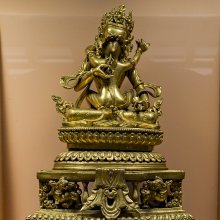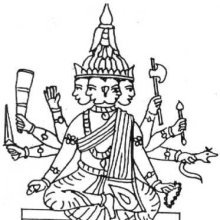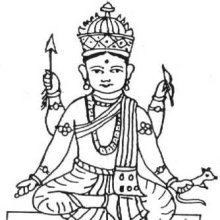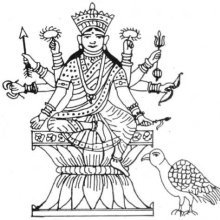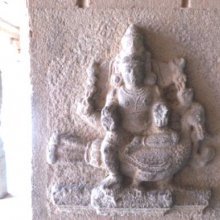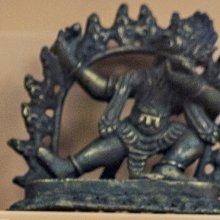Thunderbolt: 1 definition
Introduction:
Thunderbolt means something in Hinduism, Sanskrit. If you want to know the exact meaning, history, etymology or English translation of this term then check out the descriptions on this page. Add your comment or reference to a book if you want to contribute to this summary article.
Images (photo gallery)
(+32 more images available)
In Hinduism
Yoga (school of philosophy)
Source: ORA: Amanaska (king of all yogas): A Critical Edition and Annotated Translation by Jason BirchThunderbolts (in Sanskrit: Vajra) do not hurt those students of Yoga having practiced for over six years, according to the Śivayogadīpikā, an ancient Sanskrit text dealing with Yoga possibly corresponding to the Śivayoga quoted in Śivānanda’s Yogacintāmaṇi.—Accordingly, [while describing a sequence of Haṭhayoga practices]: “Thus, by means of this Haṭhayoga which has eight auxiliaries, those [students who are] life-long celibates obtain the Siddhis of the [best of Sages] because of their untiring practice. [...] In the fifth year, he has clairaudience, the Siddhi of speech and [the power to] enter the bodies of other [beings]. Within six [years,] he cannot be pierced by even a thunderbolt (vajra), he can move extremely quickly and has clairvoyance. [...]”.

Yoga is originally considered a branch of Hindu philosophy (astika), but both ancient and modern Yoga combine the physical, mental and spiritual. Yoga teaches various physical techniques also known as āsanas (postures), used for various purposes (eg., meditation, contemplation, relaxation).
See also (Relevant definitions)
Starts with: Thunderbolt flower.
Full-text (+924): Vajra, Asani, Pavi, Shatakoti, Svaru, Vajrapata, Bahudhara, Vajrayudha, Svarus, Jambhari, Ribhuksha, Dadhicyasthi, Kulisha, Jasuri, Chidaka, Dambholi, Sridaku, Bhidura, Potra, Indrapraharana.
Relevant text
Search found 155 books and stories containing Thunderbolt; (plurals include: Thunderbolts). You can also click to the full overview containing English textual excerpts. Below are direct links for the most relevant articles:
Brihat Samhita (by N. Chidambaram Iyer)
Chapter 36 - Signs of Aerial City (gandharvanagara-lakṣaṇa)
Chapter 13 - On the constellation of Saptarṣi (seven Ṛṣis or Sages)
Brihad Bhagavatamrita (commentary) (by Śrī Śrīmad Bhaktivedānta Nārāyana Gosvāmī Mahārāja)
Verse 1.6.31-32 < [Chapter 6 - Priyatama (the most beloved devotees)]
Verse 1.6.65 < [Chapter 6 - Priyatama (the most beloved devotees)]
Verse 2.4.38 < [Chapter 4 - Vaikuṇṭha (the spiritual world)]
Brahma Sutras (Shankaracharya) (by George Thibaut)
I, 3, 39 < [First Adhyāya, Third Pāda]
I, 3, 32 < [First Adhyāya, Third Pāda]
III, 4, 8 < [Third Adhyāya, Fourth Pāda]
Garga Samhita (English) (by Danavir Goswami)
Verse 1.14.46 < [Chapter 14 - The Liberation of Śakaṭāsura and Tṛṇāvarta]
Verse 8.13.127 < [Chapter 13 - A Thousand Names of Lord Balarāma]
Verse 5.7.52 < [Chapter 7 - The Killing of Kuvalayāpīḍa]
The Great Chronicle of Buddhas (by Ven. Mingun Sayadaw)
Part 33 - The Story of Pukkusa, the Malla Prince < [Chapter 40 - The Buddha Declared the Seven Factors of Non-Decline for Rulers]
Part 4 - The Bodhisatta heads towards the Mahābodhi < [Chapter 7 - The Attainment of Buddhahood]
Chapter 4 - Removing His Hair and becoming a Recluse < [Volume 2.1]
Satapatha-brahmana (by Julius Eggeling)
Kāṇḍa VII, adhyāya 3, brāhmaṇa 2 < [Seventh Kāṇḍa]
Kāṇḍa III, adhyāya 7, brāhmaṇa 2 < [Third Kāṇḍa]
Kāṇḍa I, adhyāya 2, brāhmaṇa 5 < [First Kāṇḍa]
Related products
